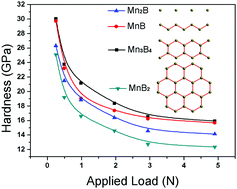Double-zigzag boron chain-enhanced Vickers hardness and manganese bilayers-induced high d-electron mobility in Mn3B4
Abstract
The D7b-type structure Mn3B4 was fabricated by high-temperature and high-pressure (HPHT) methods. Hardness examination yielded an asymptotic Vickers hardness of 16.3 GPa, which is much higher than that of Mn2B and MnB2. First principle calculations and XPS results demonstrated that double zigzag boron chains form a strong covalent skeletons, which enhances this structure's integrity with high hardness. Considering that the hardensses of MnB and Mn3B4 are higher than those of Mn2B and MnB2, zigzag and double zigzag boron backbones are superior to isolated boron and graphite-like boron layer backbones for achieving higher hardness. This situation also states that a higher boron content is not the sole factor for the higher hardness in the low boron content transition metal borides. Futhermore, the co-presence of metallic manganese bilayers contribute to the high d-electron mobility and generate electrical conductivity and antiferromagnetism in Mn3B4 which provide us with a new structure prototype to design general-purpose high hardness materials.



 Please wait while we load your content...
Please wait while we load your content...